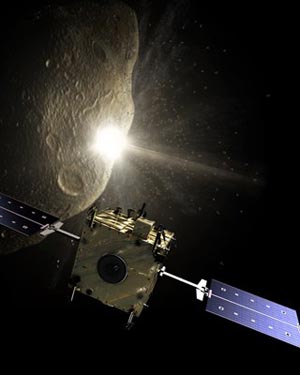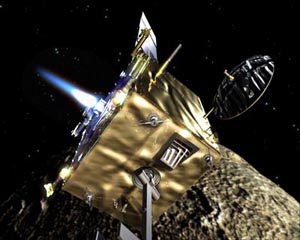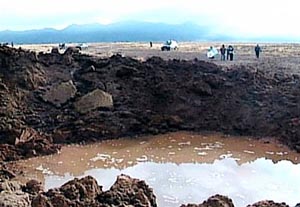A meteorite smashed into Peru recently. Fortunately, no one was injured by the immediate impact, but a lot of people who rushed to see the crate subsequently became ill. Initially, reports blamed toxic gas from the meteorite itself, but scientific analysis of the site revealed that arsenic from the groundwater was the cause of the ill effects. Such impacts as well as the bigger threat of a much larger and more widely devastating impact from a passing asteroid makes the European Space Agency’s studies on the Don Quijote mission look all the more pertinent.
Earlier work by ESA scientists demonstrated that smaller pieces of rock, none more than a few hundred metres across represent a higher overall risk than larger meteorites over one kilometre in diameter, at least for the time being. A worldwide network of astronomers is currently cataloguing most of these larger objects and various survey telescopes are also hoping to track around 90% of all near-earth objects as small as 140 metres by the year 2020. After this time, we can make a more informed decision about whether space-based observatories are needed to find the rest.

Don Quijote tilting at asteroids (Credit: Courtesy of ESA – AOES Medialab)
Fixing the orbits of small interplanetary chunks of rock is a difficult task, especially from the ground. ESA has thus been concentrating on a concept mission to physically mark a cross on several small asteroids so that we can check the state of the art of detection and tracking technology. The Don Quijote studies propose a two phase project.
In the first phase, a spacecraft would rendezvous with an asteroid and go into orbit around it. It would monitor the asteroid for several months, precisely determining its position, shape, mass and gravity field. In the second phase, another spacecraft would slam into the asteroid at a speed of around 10 kilometres per second, while the first spacecraft watches, looking for any changes in the asteroid’s trajectory.

Don Quijote tilting at asteroids
This two-craft mission would do something never achieved before, an attempt to shift the orbit of an asteroid and to measure its movement. Don Quijote will start small and the first spacecraft, Sancho, will be able to reach any one of five or six nearby small asteroids. Each one is no larger than a few hundred metres in diameter. The mission planners are focusing on Apophis, a small asteroid that swings dangerously close to Earth on its outbound orbital stretch around the Sun. The idea is to get the technology ready before you really need it, explains Ian Carnelli, Don Quijote Technical Officer, The studies carried out so far set the right context for the investigation of a small mission.

Meteorite crater
Scientists estimate that an impact on the scale of the Tunguska impact in remote Siberia, which devastated two thousand square kilometres, probably occur once every 150 years or so. The Tunguska centenary is in 2008, so the clock is ticking and now is the time to learn as much as we can about our rocky neighbours before they come knocking.
Further reading
NEO Space mission preparation
http://www.esa.int/SPECIALS/NEO/SEMZRZNVGJE_0.html
Suggested searches
meteorites
asteroids
near Earth objects